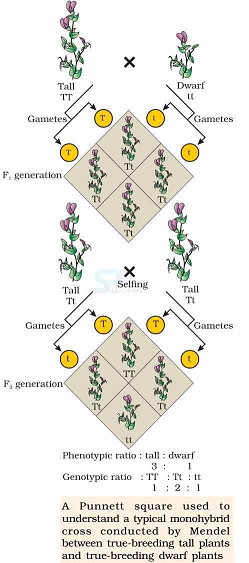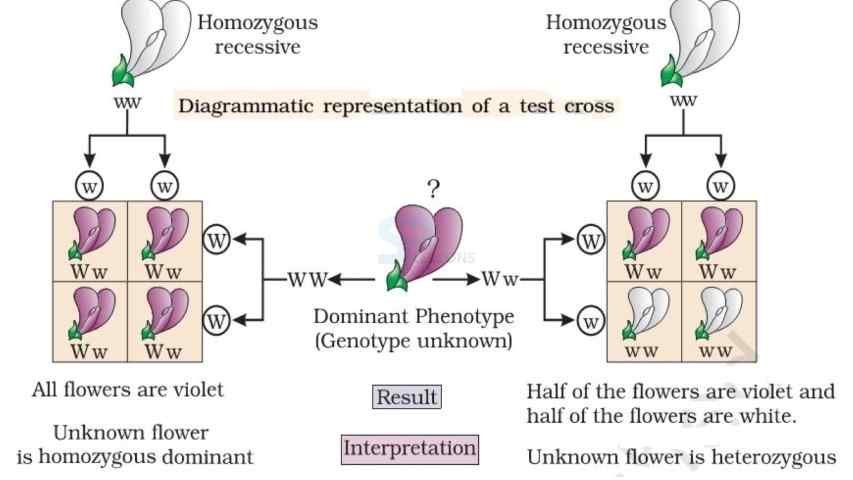 Introduction
Introduction
Q. What is Mendel’s Experiments on Inheritance?
Ans: Inheritance is the process by which characters are passed on from parent to progeny, it is the basis of heredity. Variation is the degree by which progeny differ from their parents. It was only during the mid-nineteenth century that a major headway was made in the understanding of inheritance. Gregor Mendel conducted hybridization experiments on garden peas for seven years (1856-1863) and proposed the laws of inheritance in living organisms.
 Key Points
Key Points
- Mendel conducted such artificial pollination/cross-pollination experiments using several true-breeding pea lines.
- True breeding line - A true breeding line is one that, having undergone continuous self-pollination, shows the stable trait inheritance and expression for several generations.
- Mendel investigated characters in the garden pea plant that were manifested as two opposing traits, e.g., tall or dwarf plants, yellow or green seeds etc.
- Let us take the example of one such hybridization experiment carried out by Mendel where he crossed tall and dwarf pea plants to study the inheritance of one gene.
- He collected the seeds produced as a result of this cross and grew them to generate plants of the first hybrid generation. This generation is also called the Filial1 progeny or the F1.
- Mendel observed that all the F1 progeny plants were tall, like one of its parents; none were dwarf.
- He made similar observations for the other pairs of traits – he found that the F1 always resembled either one of the parents and that the trait of the other parent was not seen in them.
- Mendel then self-pollinated the tall F1 plants and to his surprise found that in the Filial 2 generation some of the offspring were ‘dwarf’ the character that was not seen in the F1 generation was now expressed.
- The proportion of plants that were dwarf were 1/4th of the F2 plants while 3/4th of the F2 plants were tall.
- The tall and dwarf traits were identical to their parental type and did not show any blending, that is all the offspring were either tall or dwarf, none were of in between height.
- Similar results were obtained with the other traits that he studied: only one of the parental traits was expressed in the F1 generation while at the F2 stage both the traits were expressed in the proportion 3:1. The contrasting traits did not show any blending at either F1 or F2 stage.
 Factors
Factors
- Based on these observations, Mendel proposed that something was being stably passed down, unchanged, from parent to offspring through the gametes, over successive generations. He called these things as ‘factors’.
- Now we call the ‘factors’ as genes. Genes, therefore, are the units of inheritance. They contain the information that is required to express a particular trait in an organism.
- Genes which code for a pair of contrasting traits are known as alleles i.e., they are slightly different forms of the same gene.
- If we use alphabetical symbols for each gene, then the capital letter is used for the trait expressed at the F1 stage and the small alphabet for the other trait.
- For example, in case of the character of height, T is used for the Tall trait and t for the ‘dwarf’, and T and t are alleles of each other. Hence, in plants, the pair of alleles for height would be TT, Tt or tt.
- Genotype and Phenotype TT and tt are called the genotype of the plant while the descriptive terms tall and dwarf are the phenotype.
- Mendel proposed that in a true breeding, tall or dwarf pea variety the allelic pair of genes for height are identical or homozygous, TT and tt, respectively. On the other hand, the allelic pair Tt is heterozygous.
- From the observation that the recessive parental trait is expressed without any blending in the F2 generation, we can infer that when the tall and dwarf plant produces gametes, by the process of meiosis, the alleles of the parental pair separate or segregate from each other and only one allele is transmitted to a gamete.
- This segregation of alleles is a random process and so there is a 50 percent chance of a gamete containing either allele, as has been verified by the results of the crossings. In this way, the gametes of the tall TT plants have the allele T and the gametes of the dwarf tt plants have the allele t.
- During fertilisation, the two alleles, T from one parent say, through the pollen, and t from the other parent, then through the egg, are united to produce zygotes that have one T allele and one t allele. In other words, the hybrids have Tt. Since these hybrids contain alleles which express contrasting traits, the plants are heterozygous.
- What would be the phenotype of a plant that had a genotype Tt? As Mendel found the phenotype of the F1heterozygote Tt to be exactly like the TT parent in appearance, he proposed that in a pair of dissimilar factors, one dominates the other (as in the F1) and hence is called the dominant factor while the other factor is recessive.
- In this case, T (for tallness) is dominant over t (for dwarfness), that is recessive. He observed identical behavior for all the other characters/trait-pairs that he studied.
- It is convenient (and logical) to use the capital and lower case of an alphabetical symbol to remember this concept of dominance and recessiveness.
- Alleles can be similar as in the case of homozygotes TT and tt or can be dissimilar as in the case of the heterozygote Tt.
- Since the Tt plant is heterozygous for genes controlling one character (height), it is a monohybrid and the cross between TT and tt is a monohybrid cross
- The production of gametes by the parents, the formation of the zygotes, the F1 and F2 plants can be understood from a diagram called Punnett Square
- The Punnett Square above shows the parental tall TT (male) and dwarf tt (female) plants, the gametes produced by them and, the F1 Tt The F1 plants of genotype Tt are self-pollinated.
- The F1 plant of the genotype Tt when self-pollinated, produces gametes of the genotype T and t in equal proportion.
- When fertilisation takes place, the pollen grains of genotype T has a 50 percent chance to pollinate eggs of the genotype T, as well as of genotype t.
- Also, pollen grains of genotype t have a 50 percent chance of pollinating eggs of genotype T, as well as of genotype t. As a result of random fertilisation, the resultant zygotes can be of the genotypes TT, Tt or tt.
- From the Punnett square, it is easily seen that 1/4th of the random fertilisations lead to TT, 1/2 lead to Tt and 1/4th to tt.
- Though the F1 has a genotype of Tt, the phenotypic character seen is ‘tall’.
- At F2, 3/4th of the plants are tall, where some of them are TT while others are Tt.
Image:Punnett Square
Source: NCERT Text Books
- Externally it is not possible to distinguish between the plants with the genotypes TT and Tt. Hence, within the genopytic pair Tt only one character ‘T’ tall is expressed. Hence the character T or ‘tall’ is said to dominate over the other allele t or ‘dwarf’ character.
- It is thus due to this dominance of one character over the other that all the F1 are tall (though the genotype is Tt) and in the F2 3/4th of the plants are tall (though genotypically 1/2 are Tt and only 1/4th are TT).
- This leads to a phenotypic ratio of 3/4th tall (1/4 TT + 1/2 Tt) and 1/4th tt, i.e., a 3:1 ratio, but a genotypic ratio of 1:2:1.
- The genotypic ratios can be calculated by simply looking at the phenotype of a dominant trait but it is not possible to know the genotypic composition.
- That is, for example, whether a tall plant from F1 or F2 has TT or Tt composition, cannot be predicted.
- Therefore, to determine the genotype of a tall plant at F2, Mendel crossed the tall plant from F2 with a dwarf plant. This he called a test cross.
- In a typical test cross, an organism (pea plants here) showing a dominant phenotype (and whose genotype is to be determined) is crossed with the recessive parent.
- The progenies of such a cross can easily be analyzed to predict the genotype of the test organism.
- Figure shows the results of typical test cross where violet colour flower(W) is dominant over white colour flower(w).






